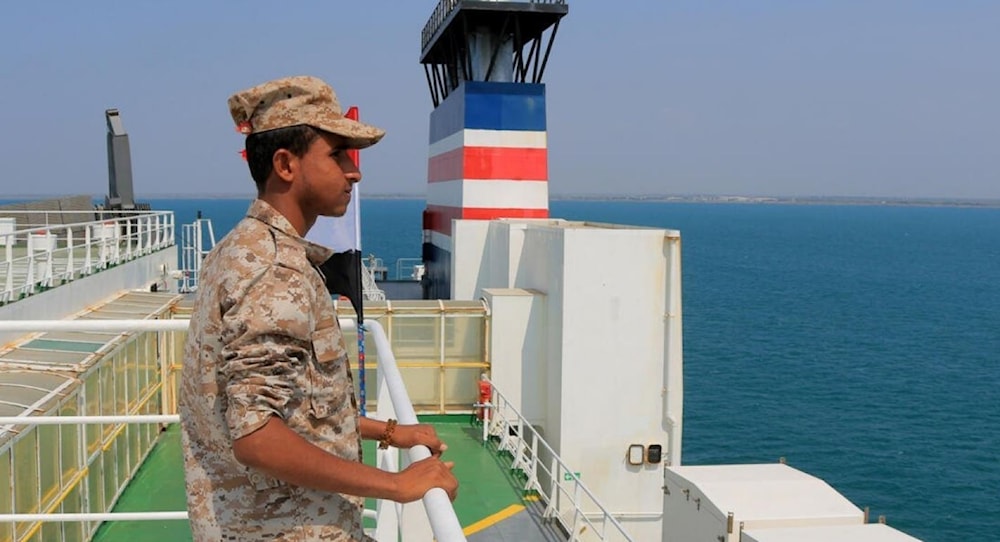Yemen’s Ansar Allah educates US Pentagon militarily: NYT
Military officials state that Ansar Allah honed their skills in irregular warfare over years of Saudi-led aggression against Yemen, coming out as a formidable US foe.
-

A Yemeni soldier stands aboard the Israeli-linked Galaxy Leader ship captured last month by Ansar Allah. (AFP)
For an extended period, the resourceful Ansar Allah proved adept at troubling American allies in the Middle East to the extent that Pentagon strategists began emulating some of their tactics.
That’s the take offered by Helene Cooper, a Pentagon correspondent for The New York Times, and Eric Schmitt, a national security correspondent for The New York Times.
Highlighting Ansar Allah's success in repurposing readily available commercial radar systems from boating stores and enhancing their portability, a senior US commander tasked Marines with devising a comparable solution. By September 2022, Marines in the Baltic Sea were implementing mobile radar systems inspired by the ingenuity of Ansar Allah.
Senior Pentagon officials recognized early on, with the onset of Ansar Allah operations in the Red Sea, that bringing them under control would pose a significant challenge, as per the analysis.
As the Biden administration enters its third week of conducting airstrikes against Yemen, the analysis contends that the Pentagon faces an extremely delicate task: weakening Ansar Allah's capacity to target commercial and Navy vessels without entangling the United States in a protracted war.
Another difficult task for the US
It is a challenging undertaking, further complicated by the fact that Ansar Allah has mastered the strategies of unconventional warfare, as per statements from American military officials. The Resistance movement lacks significant large weapons storage facilities that American fighter jets could target, given that its fighters are consistently mobile, launching missiles from pickup trucks on secluded beaches before swiftly relocating.
This raises the question of the possible impact, if any, of what the US designates as "successful" attacks in Yemen.
The analysis further explicates that the initial wave of US-led airstrikes, conducted nearly two weeks ago, targeted almost 30 locations in Yemen, "successfully destroying approximately 90 percent of the designated targets," according to Pentagon officials. However, the officials conceded that Ansar Allah still maintained around 75 percent of their capability to launch missiles and drones at ships navigating the Red Sea.
In response, the Pentagon executed seven additional rounds of strikes. Despite these assaults, Ansar Allah persists in its attacks on ships transiting the Red Sea in support of the Palestinian people in the wake of the Israeli genocide in Gaza.
“There is a level of sophistication here that you can’t ignore,” said Gen. Joseph L. Votel, who led the U.S. military’s Central Command from 2016 to 2019, as quoted by NYT, in reference to the then Saudi-led aggression on Yemen.
The current strategy employed by the Pentagon involves deploying armed Reaper drones and various surveillance platforms in Yemeni airspace. This allegedly enables US warplanes and ships to target mobile Ansar Allah locations as they emerge.
However, officials indicate that efforts will persist in targeting mobile objectives, while analysts explore additional fixed targets.
After almost ten years of Saudi airstrikes, Ansar Allah became adept at hiding their assets, placing certain launchers and weapons in urban settings and firing missiles from the rear of vehicles or tractors before quickly departing, as per the analysis.
This comes as the Pentagon announced on Sunday that two Navy SEALs initially reported missing during the operation are now confirmed dead following a comprehensive 10-day search. In the alleged operation, the US Navy claimed that commandos, with support from helicopters and drones, boarded a boat and seized propulsion and guidance systems, warheads, and other items.
“It’s mind-blowing, the diversity of their arsenal,” said Fabian Hinz, an expert on missiles, drones, and the Middle East at the International Institute for Strategic Studies in London, as quoted by NYT.
Considering the tough situation for the US, military analysts asserted that the United States and its coalition partners are left with just three practical choices. They could seize the alleged weapons arriving by sea, locate the missiles through thorough intelligence efforts, or target the launch sites directly.
The third option proves to be the most challenging, the analysis explains. Ansar Allah fighters are suspected of concealing mobile missile launchers in various locations, ranging from inside culverts to beneath highway overpasses, it added.
The effectiveness of Ansar Allah's mobile tactics against Saudi Arabia prompted the Marines to initiate an experimental endeavor to emulate them. They devised a mobile radar, specifically a Simrad Halo24 radar available for approximately $3,000 at Bass Pro Shops, which can be installed on any fishing boat in just five minutes. Similar to Ansar Allah, the Marines are exploring ways to utilize these radars to transmit data on maritime activities.
Lt. Gen. Frank Donovan, currently serving as the vice commander of the United States Special Operations Command, observed Ansar Allah's radar tactics during his tenure leading a Fifth Fleet amphibious task force in the southern Red Sea. In an effort to understand how Ansar Allah fighters were targeting ships, General Donovan considered that they might be utilizing off-the-shelf radars mounted on vehicles along the shore, making them mobile.
In response, he tasked his Second Light Armored Reconnaissance Battalion with creating a comparable system, the analysis delineates.
Read more: Biden vows to continue Yemen strikes despite admitting ineffectiveness

 5 Min Read
5 Min Read








